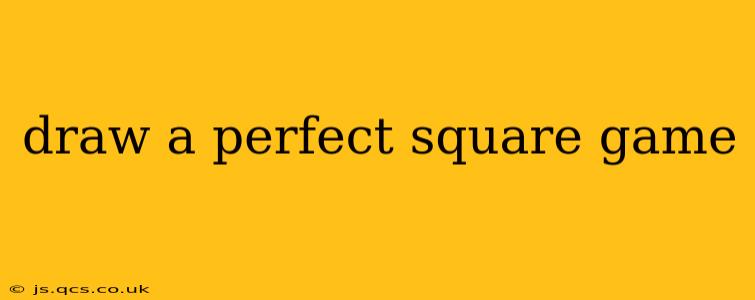Draw a Perfect Square Game: Techniques and Tips for Success
Drawing a perfect square, especially freehand, can be surprisingly challenging. This isn't just about artistry; it's about understanding geometry and developing hand-eye coordination. This guide will explore techniques to help you draw a perfect square, transforming the task from a frustrating exercise into a satisfying achievement. We'll also address some common questions people have about this seemingly simple task.
What are the challenges in drawing a perfect square freehand?
Drawing a perfect square freehand is difficult because it requires precise control over several factors simultaneously:
- Consistent Length of Sides: Maintaining the same length for all four sides is crucial. Our hands naturally tend to waver, leading to inconsistencies in length.
- Perfect Right Angles: Ensuring each corner forms a perfect 90-degree angle is another major hurdle. Our perception of angles isn't always accurate.
- Straight Lines: Drawing perfectly straight lines without rulers or other tools is a skill developed over time.
How to draw a perfect square using tools?
While freehand drawing is the challenge, let's start with the easiest method: using tools. This provides a baseline for understanding what a perfect square should look like.
- Use a Ruler and Protractor: This is the most accurate method. Use the ruler to measure the desired side length, and the protractor to ensure 90-degree angles at each corner.
- Use a Set Square: A set square (or triangle) is a tool specifically designed for drawing right angles. Combine it with a ruler for accurate side lengths.
How to draw a relatively perfect square freehand?
While achieving absolute perfection freehand is unlikely, you can significantly improve your accuracy using these techniques:
- Start with a Light Sketch: Begin with a very light sketch of a square. Don't press down hard on your pen or pencil. This allows for easier corrections.
- Focus on One Side at a Time: Concentrate on making each side as straight and consistent in length as possible. Use light, continuous strokes.
- Check Your Angles: After drawing two sides, visually check the angle formed at the corner. Try to estimate a 90-degree angle. This gets easier with practice.
- Use Light Construction Lines: You can use very light lines to create a guide for your square. This could involve lightly sketching a vertical and horizontal line to provide points of reference for your corners.
- Practice Regularly: The more you practice, the better your hand-eye coordination will become. Consistent practice is key to improving your ability.
How can I improve my hand-eye coordination for drawing squares?
Improving hand-eye coordination is a gradual process. Here are some helpful exercises:
- Simple Line Drawing: Practice drawing straight lines of varying lengths without rulers. Focus on consistency and smoothness.
- Geometric Shapes: Practice drawing other geometric shapes like circles, triangles, and rectangles. This helps refine your ability to control your hand movements.
- Copying Drawings: Copy drawings from reference images. This builds your observational skills and helps you replicate shapes accurately.
Are there any other games or activities to help?
While not strictly "games," activities focused on precision and hand-eye coordination can significantly improve your ability to draw a perfect square:
- Jigsaw Puzzles: Working on jigsaw puzzles enhances fine motor skills and spatial reasoning.
- Drawing Games: Many drawing games on apps or websites require precise movements and control. These games often offer varying levels of difficulty and visual feedback.
By combining practice with the techniques outlined above, you'll be well on your way to drawing increasingly accurate squares, freehand or with tools. Remember, consistency and patience are essential in mastering any drawing skill.
